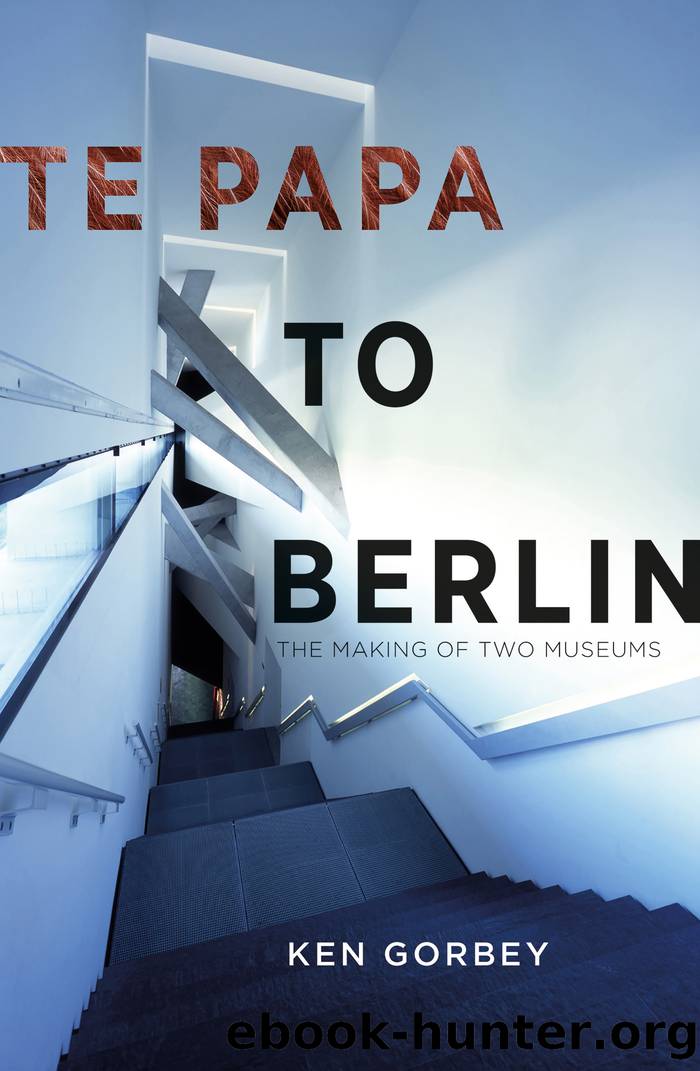Te Papa to Berlin by Ken Gorbey

Author:Ken Gorbey
Language: eng
Format: epub
Publisher: Otago University Press
Published: 2020-08-15T00:00:00+00:00
CHAPTER 13
DANIEL LIBESKIND, ARCHITECT
âHELLO â YOUâRE THE FIFTH DIRECTOR IâVE WORKED WITH,â and Daniel listed them.
It was early in our Berlin residency, spring 2000, and I had arranged to meet architect Daniel Libeskind. Susan and I were uncertain what to expect. I had already read of Libeskind described as Woody Allen on speed. And I had it from colleagues in the international museum community that he was no âloving childâ, the literal translation of his name, but, rather, a harsh infighter and a person to be wary of. Mind you, none of these commentators had ever met him and that reputation undoubtedly came from the vicious fight some years back to make sure the museum was not cast upon the scrapheap of bright, never realised architectural projects. Even now, with the museum built, the hurt of that campaign was still fresh.
We stood outside the museum. It was a Sunday, one of those brilliantly fine early spring days when the sky above Berlin does its very best to be blue. Few people were about. I was tense, even anxious.
Libeskind arrived with his wife and business partner Nina. They were a short couple but up close their bright and open faces dominated all else. There was a generous sparkle as Daniel put names to those who had gone before, evidence of various executive arrangements tried, failed, rejected. We relaxed, and in no time were joking. I am sure that this couple could be very tough when required but right from this first meeting it was humour, as well as Danielâs building, that bonded us. It was the beginnings of not just a partnership but an easy friendship.
âWe were crossing this street after the competition award ceremony.â Nina indicated Lindenstrasse. âI turned to Daniel and said, âDo you really want to build this thing?â and he said, âYesâ, and I said, âRight, letâs do it!â At that time we were in the midst of a shift from Italy to the States. Daniel had a new position. Our household stuff was already being shipped, but I took charge and organised everything to be reloaded and moved to Berlin.â
Daniel was architect as academic. The Jewish Museum Berlin was not just his first museum, it was his first building. Photos show the professor in front of his students, engaged in architecture as theatre, perhaps the Woody-Allen-on-speed reference. The chalkboard behind him full of powerful, if obtuse, diagrams.
*
The Berlin City Museum, on the other hand, was no theatre, nor did it have a single driving idea that captured attention. Levels of excitement and expectations were set low and nothing lifted it above the noise of other cultural happenings. Its collections were slight, of interest to a limited group. It had no champions. As a result, the economic recovery of Germany after the war, the Wirtschaftswunder, had not touched this place. Other cultural institutions, opera, music, theatre, dance and museums, had new buildings to replace bombed-out ruins. But the Berlin City Museum, infrequently visited and with minimal profile,
Download
This site does not store any files on its server. We only index and link to content provided by other sites. Please contact the content providers to delete copyright contents if any and email us, we'll remove relevant links or contents immediately.
| Africa | Americas |
| Arctic & Antarctica | Asia |
| Australia & Oceania | Europe |
| Middle East | Russia |
| United States | World |
| Ancient Civilizations | Military |
| Historical Study & Educational Resources |
The Third Pole by Mark Synnott(677)
Money for Nothing by Thomas Levenson(626)
Christian Ethics by Wilkens Steve;(571)
The Economist (20210109) by calibre(566)
Made in China by Anna Qu(540)
100 Posters That Changed The World by Salter Colin T.;(498)
Reopening Muslim Minds by Mustafa Akyol(485)
Routledge Handbook of Contemporary India by Knut A. Jacobsen(477)
The Irish Buddhist by Alicia Turner(472)
Nonstate Warfare by Stephen Biddle(466)
Culture by Terry Eagleton(461)
The Great Pyramid Void Enigma by Scott Creighton(451)
The Age of Louis XIV: The Story of Civilization by Will Durant(440)
Ideology by Eagleton Terry;(436)
The Shortest History of China by Linda Jaivin(432)
Objects of Vision by Saab A. Joan;(426)
Banaras: CITY OF LIGHT by Diana L. Eck(424)
The Jews of Silence: A Personal Report on Soviet Jewry by Elie Wiesel(421)
Sybille Bedford by Selina Hastings(411)
